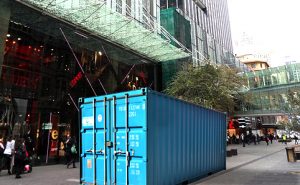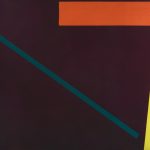Moshe Rosensveig is the Dr. Frankenstein of Australian photography – Head On, the photo festival he started five years ago, has become a certified monster. There are no fewer than 37 ‘featured’ exhibitions and almost 70 ‘associated’ exhibitions spread across the city, involving an estimated 900 artists. The program also boasts 150 events, including workshops, talks and fairs.
In approaching such a gargantuan performance one has to stand well back and take a long run-up, like a pole-vaulter. But having been overseas for the best part of a month I haven’t seen much of the festival and can’t offer any useful criticism. It’s rather like arriving in the middle of a party when everyone else is drunk.

Nevertheless, Head On is simply too big and too popular to be ignored. It attests to an overwhelming public interest in photography as the democratic art form of our age, and confirms Sydney’s status as the event capital of Australia. There can’t be much room left in the calendar when one blocks out Head On, Vivid, Sculpture by the Sea, the Gay Mardi Gras and various other public extravaganzas. If you have any spare time there are at least 20 film festivals every year, including the Sydney Film Festival, which kicks off next Wednesday.
These public attractions are drawing large numbers at a time when the Art Gallery of NSW has struggled for attendances. This may reflect a change in people’s viewing habits, or simply a lackluster program at the state gallery. Meanwhile the Museum of Contemporary Art has just announced its 2 millionth visitor, a statistic only slightly more believable than one of Tony Abbott’s election promises.
If I had to recommend a few highlights from this year’s Head On program, first up would be an exhibition by Benjamin Lowy, one of the world’s leading news photographers, at the Paddington Reservoir Gallery on Oxford St. Then there’s the great American photographer, Mary Ellen Mark, showing at Stills Gallery, Paddington; and The Genesis Project, at M Contemporary, Woollahra, featuring the work of 19 prominent photographers. The idea is to show the particular image that made each participant think of him or herself as a photographer for the first time: 19 Eureka! moments.

Naturally this represents only a fraction of the work on display so don’t treat my hunches as definitive. One area where I’m completely confident is the extraordinary talent of Michael Johnson, who is showing a selection of early works with Annette Larkin, in an exhibition titled: London Sydney New York: Paintings and Works on Paper, 1960s & 1970s.
In recent years it has become commonplace for people to say: “Oh, Michael Johnson, I really like the early ones.” While this is manifestly unfair to Johnson’s most recent work, personal taste is not to be disputed. Instead, Johnson has given his lukewarm admirers what they wanted by putting together this survey of pictures made in a range of styles that might be grouped under the label “Colour Field”. He won’t allow the other obvious epithet, “Hard Edge”, because a surprising amount of this work has been made without the use of masking tape.
To properly appreciate Johnson’s achievements one must put both this early work and the recent pictures in context with his breakthrough exhibitions of 1986, when he arrived back on the scene with the force of an atomic bomb after years spent in New York.
Those paintings, with their mastery of colour; heavily-laden surfaces, and allusions to landscape, were like nothing else in Australian art. If Johnson’s manner has lost some of its impact through repetition this takes nothing away from those remarkable canvases of the 1980s.
The first impression one takes away from the 60s and 70s paintings is their exceptional freshness. The wheel of fashion has turned so decisively that these pictures look absolutely contemporary. The paradox, however, is that an artist making such works today could only do it inside invisible quotation marks, in acknowledgement of the twilight stages of Modernism.
Johnson’s paintings are the real thing, but it would be wrong to praise them simply on the grounds of their authenticity with no thought to their particular qualities. What strikes one most forcefully is the colour: bright, crisp, leaping off the canvas, but never predictable. Nobody can use colour, or indeed talk about colour, like Johnson: “Energy resides… in the expansion and contraction of colour. Geometry is just the aperture.”
And again: “There is no art ‘from nature’ because the palette is a chemical echo.”
Unlike the laborious artspeak found in publications such as the Biennale catalogue, Johnson’s formulations are more akin to poetry. He is dealing with abstract art, striving to find ways of describing his experience as a painter. He wants to draw a line between the constructed forms of a painting and the random structures of nature, but every part of his work attests to his sensitivity to the natural world.
Sofala (1964) reduces the winding road that leads to this bush hamlet to a severe double line that slices through a field of pure orange. Sharp (1964) is both wave and mountain – an uneven slice of dark purple set against a bright yellow ground. Frontal (1968) blurs the distinction between painting and sculpture, setting four burgundy-coloured planks on an orange field, enclosed by two black columns.
The New York paintings, such as Senegal Friend (1974), use flat geometric colour shapes on another dark purple field. The tones are chosen to provide extremities of contrast and complementarity, making the eye work hard to encompass this vista of infinite space punctuated by luminous bars of light.
Even the smallest, simplest works are notable for their pictorial intelligence. Anna (1964), which has the vague association of a baby’s head appearing at the moment of birth, links the symmetry of the image to the palindrome of the title: an-na. It may seem trivial, but Johnson’s work is full of small details that lift it above the mere pursuit of abstraction as a stylistic or ideological gesture.
Think of those artists who believe they are doing something very radical in painting flat monochromes, and then think of Johnson’s artful juxtapositions of colour.
The key to these works and to the far more complex paintings he would go on to create, is the relationship between colours; or as Johnson puts it: “the power of one colour to completely transform another by virtue of placement or proximity.”
From this simple insight springs a language of painting with an infinite range of expression. To stand in a room surrounded by Johnson’s works is to be pulled and prodded in many directions simultaneously. Even those walking past the gallery tend to stop and stare through the glass. It’s rare to find paintings with such inherent magnetism, such an aggressive need to be seen.
Incidentally, it’s a very good time to visit the Danks St. complex. Apart from Johnson’s show and various manifestations of Head On, the Janet Clayton Gallery has an excellent group exhibition by four well-known sculptors; while Stella Downer is showing typically painstaking new 2 and 3D work by one of Newcastle’s finest – Trevor Weekes.
I’ll end this rambling column by bidding farewell to Eva Breuer Art Dealer, which has been a successful and popular gallery for over twenty years. After Eva’s death in 2010, the gallery was continued by her daughter, Nicky McWilliam, whose burgeoning legal career leaves little time for other occupations. Chalk up another closure in a commercial gallery sector that is rapidly contracting.
The final Eva Breuer show is 2014 Timescape by Victor Rubin, a prolific painter well known to Sydney audiences, even though he has been living in Melbourne for over a decade. Rubin has energy to burn, but has so many competing ideas that his shows are always anthologies of themes, techniques and motifs. The present show has a few large pictures and a lot of ‘little gems’, testifying to the labyrinthine pathways of the artist’s mind. As always, there is a vibrant, celebratory aspect to Rubin’s efforts. He’s a painter who loves what he does, and his exhibition closes the curtain on the gallery with an appropriate fanfare.
Head On Photo Festival
www.headon.com.au
Until 8 June.
Michael Johnson: London – Sydney – New York 1960s & 1970s
Annette Larkin Fine Art
Until 14 June.
Eva Breuer Art Dealer
Victor Rubin: 2014 Timescape
Closes today.
Published in the Sydney Morning Herald, Saturday 31 May, 2014









